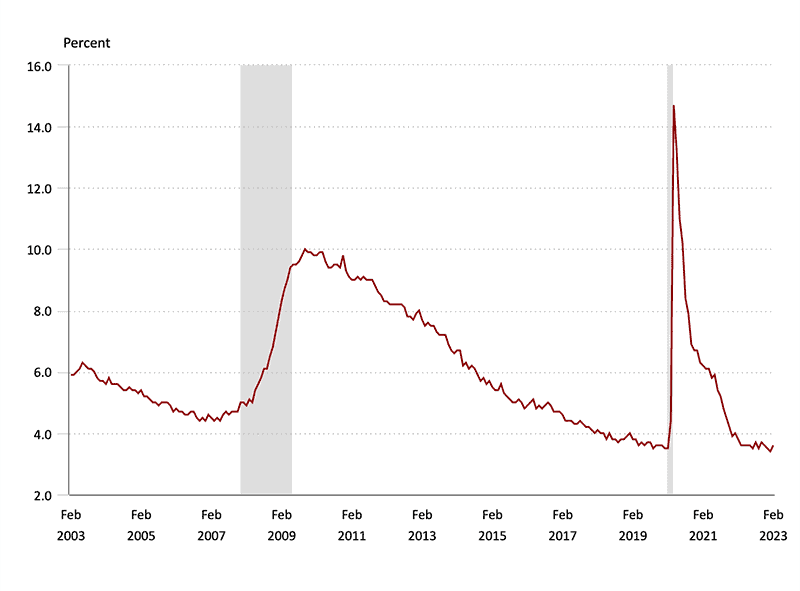Summary
The Bureau of Labor Statistics’ (BLS) monthly Employment Situation report is an indicator of economic well being and the state of the labor market in particular. This report is released on the first Friday of every month and is based on two surveys: the establishment survey and the household survey.
The establishment survey is based on a survey of non-farm businesses and government agencies and provides information on the number of jobs added or lost in a given month. This survey includes data on various industries, such as retail, manufacturing, healthcare, and education.
The household survey is based on a survey of households and provides information on the unemployment rate and labor force participation rate. This survey also includes data on various demographic groups, such as age, race, and gender.
Key Takeaways
- Hispanic unemployment has seen a rise from 4% in November 2022 to 5.3% in February 2023
- The nation remains at lower than full employment with a 3.5% unemployment rate though Blacks and Hispanics still have elevated unemployment levels at 5.7% and 5.3%, respectively.
- The employment-to-population ratio remains at about 60% for both Blacks and Whites though is stronger for Hispanics at about 67% and Asian Americans at about 63%.
- Black and Hispanic unemployment rates often spike before other groups when a recession begins. The February jobs report may flame the fears of a recession if it turns into a trend.
The latest monthly jobs report from the Bureau of Labor Statistics (BLS) provides important insights into the current state of the US labor market. In February 2023, there was an increase of 311,000 new jobs. The industries reporting the greatest number of new jobs were led by leisure and hospitality, professional and business services and health care. Other industries adding jobs this month include manufacturing, transportation, construction, social assistance and retail. Across these industries, the average hourly wages increased as well, ranging from a 4.2% increase for healthcare workers to 6.9% among social assistance and hospitality workers.
The overall unemployment rate for February 2023 was 3.5%, a slight increase of 0.1% from January. This continues a trend of historically low unemployment rates and suggests that the labor market is strong. The unemployment rates across all groups remain at or near 20-year low points. However, the gap between non-White and White unemployment remains. The unemployment rate for Black workers in February was 5.7%, a 0.3% increase from January although it is still almost 1% lower than it was in February 2022 and is still lower than pre-Pandemic Black unemployment.
Black unemployment 2003-2023
Click on image for interactive chart
Source: U.S. Bureau of Labor Statistics
This month, Black men and women were moving in opposite directions but both arrived at 5.1% unemployment. For all Black workers, including those under 20, unemployment was 5.7%. This difference was driven by high Black teen unemployment at 20.4%, which was more than double White teen unemployment. In the last year, the unemployment rate for Black men fell 1.3%, and the gap between them and White men was 2.5%, although unemployment for Black men was still close to double the unemployment rate for White men. Black women also saw improvement. Their 5.1% unemployment rate was .9% lower than a year ago .
In what may be a warning sign for some parts of the economy, the unemployment rate for Hispanic workers continued to rise. At 5.3%, Hispanic unemployment remains historically low, but is 0.8% higher than this time last year. Hispanic workers were concentrated in industries such as leisure and hospitality (25%), transportation and warehousing (21%) and construction (34%).
Black and Hispanic unemployment rates often spike before other groups when a recession begins. As uncertainty over the chances of a recession remains high, this jobs report may flame the fears of a recession if it turns into a trend.
The employment level is a measure of how many people are employed in the workforce. Since the number of new jobs is collected by the establishment survey, that figure does not offer insight into the race and gender of the workers who take those jobs. However, the employment level does give us some idea of what groups are finding more success at gaining employment. In February 2023, the overall employment level increased by 177,000 workers, a far cry from the 894,000 people that reported getting new jobs in January, the biggest increase in the previous 12 months. Black workers saw the greatest increase, with an overall change of .58%, as 119,000 more Black workers reported being employed in February compared with January. Black men in particular did well, with a gain of 1.26% in the number of them that reported being employed. Black women, after posting a 2% gain in jobs in January, saw a more modest February with only a .17% increase in net employment.
The employment-to-population ratio measures how many working age adults are in the workforce. Traditionally, Hispanic workers have seen a much higher ratio than other groups, while Black workers have lagged behind. Since the start of the pandemic, a larger share of Black adults have been employed, almost closing the gap with White workers. In February, the overall ratio remained unchanged at 60.2%, and there were slight decreases across most groups. The exception to this was Black and Hispanic women. Both groups showed slight increases in the share of working age adults that were employed.
Taken as a whole, the White House will tout this jobs report as an indicator of a strong economy. But cracks may be appearing in Black and Hispanic data, which are often harbingers of more trouble to come. As we continue to understand and adapt to the post-COVID economy and realignment of labor it has resulted in, it is important to not be distracted by the big numbers in the jobs report. The trends we observe in Black, Hispanic and women employment have broader implications for our society as a whole.
Dedrick Asante-Muhammad, Chief of Organizing, Policy, and Equity, NCRC
Jason Richardson, Senior Director of Research, NCRC
Joseph Dean, Intern, NCRC




